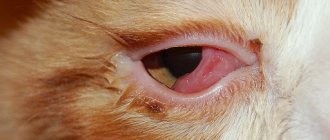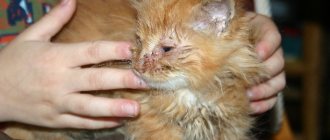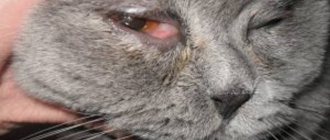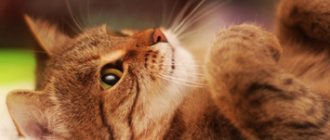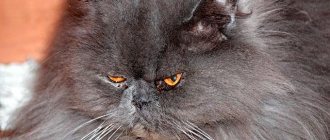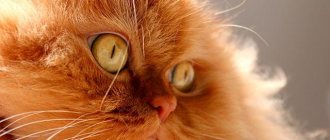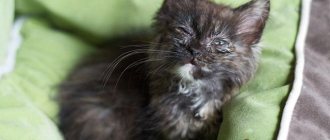Caring and loving “cat owners” have probably repeatedly noticed how their purrs sometimes “cry”, and therefore asked a natural question: why do the cat’s eyes water?
Tears help protect an animal’s eyes from dust and other foreign bodies, just like humans, in everyday life. That's why sometimes tears should appear in your cat's eyes.
It is considered natural in terms of physiology when a cat’s eyes water after sleep. He usually washes himself or you wipe the corners of his eyes with a dry cloth. Caring owners have made it a rule to periodically arrange “bath days” for their pets, carefully (so as not to damage the eyeball) by washing their eyes and ears with cosmetic pads or cotton swabs dipped in warm boiled water.
It’s another matter when the purring dog’s tearfulness is constantly observed, and this tearfulness is accompanied by a sad and lethargic appearance of the animal. Why do cats have watery eyes and what to do in such cases?
You should not perceive this process as natural, and also do not assume that in this case the purr will wash itself. “Killing” the infection at home by only washing your pet’s eyes with various disinfectants is also not advisable without the intervention of a veterinarian.
How to examine a cat if its eyes are watery?
- As tragic as it may be, often the appearance of tears in a cat’s eyes indicates the presence of some kind of disease.
- Therefore, you need to pay attention to whether tears appeared for a short time and then disappeared, or whether the discharge in your cat’s eyes is present throughout the entire day, or worse, several days.
Tears
- If the cat’s tears are insignificant, and, having appeared in the morning, soon went away, there is nothing to worry about, and there is no reason for alarm.
- If your eyes “cry” for a long time, you should look for the cause of this phenomenon.
- When examining a cat with watery eyes, start by cleaning your hands to avoid further infection. Then try pulling down the upper eyelids on each eye .
- If the eyes are not cloudy, they shine, and the pupils are the same size, and the back surface of both eyelids is pale pink, and the cornea is transparent - everything is normal with the animal’s eyes.
Examine the animal
- If the eyelids are red or swollen, or the cornea is cloudy, this means that the cat has problems with the eyes.
- If the animal has difficulty opening its eyes or the inner surface of the eyelid is pulled up by a thin light film, it is better to visit a veterinarian as soon as possible.
Cat's eyes are watery: causes and treatment
Reasons why a cat's eyes water:
- with a foreign body in the eyes . It could be some kind of speck, fluff, twig, midge, and possibly dirt. If you find something like this, the first thing you should do is rinse the animal’s eyes under running water. Once the foreign object has been washed, apply 1% tetracycline ointment to the cat's upper eyelid . It would be a good idea to show the animal to a veterinarian.
- Weakening of the immune system . This is possible if the kitten is taken away from its mother too early. But only a veterinarian can find out whether this is so. He will also develop a regimen for taking the necessary medications and adjust the animal’s diet.
- The presence of allergies , which, just like people, are inherent in cats. Allergens can be the same as for humans: dust, chemicals, pollen, etc. Here, consultation with a specialist is also necessary, since it is unlikely that the owner himself will be able to accurately determine both the allergy itself and the cause of its occurrence.
- Worms . This is a very common cause of watery eyes in cats. To exclude such a cause, the animal should be regularly treated for worms.
- Breed cats. There are several breeds that have a characteristic skull structure with a flattened nose and deformed nasolacrimal ducts. Only daily eye rinsing and special attention to hygiene in these risky areas will help.
Prone to watery eyes - Colds . If the cat also sneezes and coughs, sleeps most of the time and absorbs a lot of water, there is reason to suspect a cold . You should not treat the animal yourself; it is better to contact a veterinarian.
- Feline distemper is accompanied, in addition to discharge from the eyes, often with pus, high fever, diarrhea and vomiting, and general weakness. Self-treatment is unacceptable.
Establishing diagnosis
Before starting treatment, it is imperative to conduct a diagnosis that will help identify the true cause of excessive lacrimation and carry out effective treatment therapy. Only a veterinarian can conduct a correct and thorough examination.
Important! Before going to the veterinarian, be sure to prepare a pet card, which should indicate all vaccinations, anthelmintic treatments, and past illnesses. It is advisable to write down symptoms of malaise and other suspicious signs on a piece of paper.
Sometimes the veterinarian may be interested in the following important questions at the appointment:
- how long the symptoms last;
- how did the first symptoms of tearing from the eyes appear and the peculiarities of the course of this condition, for example, did two eyes immediately begin to water at the same time, or vice versa, first one began, and then the other, and whether there are other additional symptoms;
- when the last procedures to eliminate helminths, fleas, ticks and other parasites were carried out.
To make an accurate diagnosis, the veterinarian will definitely take a urine and stool test. It is advisable to already have the research material with you before going to the doctor. Also, at the appointment, he will definitely take mucus from the eye for examination; for this reason, there is no need to first rinse the pet’s eyes with various solutions.
Eye diseases that cause your cat's eyes to water
- Possible infection. If the eye becomes red and swollen, and pus appears, the help of a veterinarian is necessary, since feline conjunctivitis is possible.
- Direct eye disease , in particular cataracts or glaucoma . A whitened lens in the first case or a clouded cornea in the second are obvious symptoms of such diseases. Of course, treatment is only possible in a clinical setting.
- Diseases caused by viruses or fungi (such as chlamydia or toxoplasmosis) can only be treated by a specialist.
- An inflamed cornea is identified by red, watery eyes, on which a cloudy film appears.
- Entropion of the eyelid is often characteristic of Persians or, for example, sphinxes. Purulent discharge and swollen eyes are a reason to immediately visit a doctor.
- injury received if a cat got into a fight with a fellow cat, hit itself, got caught on a branch, etc. Wounds or other damage to the eyeball are symptoms of such an injury. It would be a good idea to consult a doctor to determine the severity of the injury.
From injury
You should also pay attention to the color of the discharge from the eyes.
- If the discharge is clear, similar to ordinary tears, it is most likely due to an allergy , mechanical irritation, or breed characteristics.
- If the discharge is green or yellow, mixed with pus , this indicates the presence of an infectious disease.
- If your cat's eyes are watery brown or red, it could be worms.
How to help an animal?
Only a specialist can accurately establish the cause and draw up the correct treatment regimen. But you can alleviate the animal’s condition before going to the veterinary clinic on your own. To begin with, it is important to pay attention to the symptoms accompanying lacrimation, in particular, fever, redness of the mucous membrane of the eye, diarrhea, lack of appetite, lethargy, and weakness . We further recommend:
- check that the cat has not suffered mechanical damage to the eye from a sharp or blunt object;
- make sure that the animal has not inhaled or swallowed household chemicals;
- Carefully rinse the eye with a decoction of medicinal herbs or a solution of furatsilin.
After this, the animal must be taken to a veterinarian, who will conduct a clinical examination and additional laboratory tests. In particular, to confirm the diagnosis, examinations such as:
- general examination to determine the presence of injuries or congenital deformities of the eyelids;
- analysis of discharge from the lacrimal sac for polymerase chain reaction, the presence of chlamydia and other bacteria;
- examination of the fundus (ophthalmoscopy);
- checking for patency of the nasolacrimal duct with instillation of fluorescein;
- ultrasound examination of the eye;
- general clinical tests.
In some cases, you can limit yourself to one analysis, while in others it is possible that a full diagnosis will be required. After the cause of lacrimation is determined, the doctor prescribes a treatment regimen and prescribes certain medications. The procedures themselves can be carried out at home, but at the same time follow the recommendations and do not get carried away with self-medication.
Why do Scottish Fold cats have watery eyes?
- As mentioned above, some cat breeds have a non-standard nasolacrimal duct, including Scottish, British, and Persian.
- Because of this, it does not completely remove the discharge, which is usually normal for any breed.
- The excess is eliminated through the eyes. If this happens after the cat has slept, then there is no need to worry, this is a normal physiological phenomenon.
Due to non-standard channel
- If your cat’s eyes are constantly watering , this is already outside the norm, and here it is necessary to find out the cause with the help of a veterinarian.
- Such cats need to wash at least once a week, and sometimes up to 2-3 times a day. If the discharge is normal, it is enough to wipe it periodically.
- If your eyes water frequently , you should contact a veterinarian and have your animal examined.
Treatment and prevention methods
The main methods of treating lacrimation or suppuration include the following:
- rinse both eyes of the cat with warm boiled water or a weak solution of furatsilin - several times a day as needed;
- lubricate with special ointments based on broad-spectrum antibiotics - at least twice a day;
- if there was surgical intervention - correction of entropion or eversion of the eyelids, then it is not advisable to remove the collar from the neck;
- in case of acute infections, be sure to put tetracycline ointment behind the lower eyelid and instill both eyes with chloramphenicol;
- in case of allergic reactions, give the animal hormonal or anti-allergic medications.
The duration of treatment will depend both on the pet’s immunity and the degree of development of the disease, as well as on the correctly selected procedures and medications.
It is also necessary to know that it is strictly forbidden to remove a sharp object from a cat’s eye yourself , otherwise it may negatively affect your pet’s vision. In such cases, it is necessary to urgently go to the veterinarian.
To significantly reduce the likelihood of your pet developing diseases, it is enough not to forget about the animal’s correct and nutritious diet, timely vaccination and examination at the veterinary clinic, preventive administration of anthelmintics, and compliance with basic hygiene rules.
If your cat’s health has worsened or strange behavior has appeared, contact the nearest hospital of the Aibolit Plus network of veterinary clinics. Take care of your pet’s health and don’t put off your trip until tomorrow – we will provide the necessary assistance around the clock.
How to prevent your cat's eyes from watering?
- Of course, it would be much more correct to use hygienic methods so that the cat does not have to be treated later.
- Periodically rinse the animal's eyes with a cotton swab and warm water towards the spout.
Rinse
- If you notice dried discharge from the eye, soften it and carefully remove it, then use a clean swab to rinse the eye.
- Do not use the same tampon for both eyes, use new ones.
- If your cat's eyes are watery , do not use drops or medications without consulting a veterinarian, otherwise you may make the animal sick by using the medication incorrectly.
Symptoms
The disease is manifested by several symptoms: itching of the mucous membranes, sneezing, watery nasal discharge (rhinorrhea), and nasal congestion, and sometimes even conjunctivitis. With obstruction (obstruction syndrome of the human respiratory system), headaches often occur. Allergic rhinitis can lead to complications such as sinusitis.
The causes of rhinitis can be pollen, mold spores, wool, fluff and waste products of animals (cats, dogs, rodents), dust mites, cockroaches.
Asthma is a frequent accompaniment of allergic rhinitis, but it is not yet clear whether a false runny nose is the cause of asthma or whether both of these diseases are based on the same cause - the allergic process. With asthma accompanying hay fever, the patient may experience shortness of breath and a severe cough.
A cat's eyes are watery: prevention
- If there are no problems, then for prevention you can use warm decoctions of medicinal plants intended for people (St. John’s wort, chamomile, calendula, etc.), green tea, and drops without antibiotics.
- If the veterinarian determines that the cat’s eyes are watery due to an infectious disease, use tetracycline ointment.
- For established bacterial infections, “Diamond Eyes” and their analogues are used.
What to do at home
To treat your pet's tearfulness or relieve symptoms, there are a number of steps you can take at home. If you are sure that the cat is not in danger, and it is an allergy or a mild bruise, you can wipe or rinse your pet’s eyes yourself.
Usually a weak solution of furatsilin (0.2%), chamomile decoction or even black tea is prescribed, which has a calming and disinfecting effect.
It is also recommended to make compresses from a decoction of sage, calendula and St. John's wort.
INSTRUCTIONS: How to carry out treatment prescribed by a doctor at home. You will need: a cotton pad/cotton wool, a handkerchief, a pipette/syringe without a needle and your patience and skill. Before starting the procedure, be sure to wash your hands under running water and soap. Hold the cat in your arms or on your lap.
In order to protect both you and the animal from unnecessary injuries, it will be useful to “secure” it with a scarf, or ask someone to help hold it. Be sure to talk to your cat, reassure him, and let him know that you want to help him. Soak a cotton pad in the solution and carefully moisten the resulting crust around the eyes, and remove all excess with a second circle.
Re-wipe the eye area with another clean pad soaked in water. To drop the medicine into the eyes, do the same: grab and place the cat on your lap, carefully open the eyelid with your fingers, and with the other hand, drop the medicine inside (under the eyelids or in the upper corner of the eye).
After completing all manipulations, remove any remaining medicine or ointment. As moral compensation, you can give your pet a treat.
IMPORTANT: Never use potassium permanganate solution to wash your eyes. Although it is known as an excellent disinfectant, it can damage the integrity of the eye crystalline through a burn.

